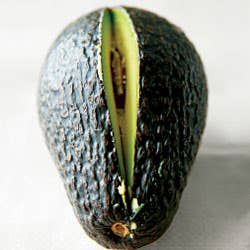
Know Your Avocados
Though the famously rich-tasting hass variety dominates the American market, hundreds of other types of avocado exist—all of them descended from three primary subspecies: West Indian, Guatemalan, and Mexican. Here are nine of our favorites.
1. DONNIE—Resembling a bright green papaya, the roughly six-and-a-half-inch-long donnie can weigh as much as one and a half pounds but has a surprisingly small seed, or pit. When this avocado is ripe, its thick skin is taut and shiny and, if the fruit rubbed against a branch as it matured, occasionally sports brown leathery patches. The donnie's light, mild flesh, low in fat, pairs well with richer ingredients such as cream and olive oil in velvety soups and salad dressings. Since it's so large, the donnie is the perfect avocado for stuffing, especially with crabmeat salad.
2. ZUTANO—This Mexican variety is ready to pick from late fall to early winter in the San Joaquin Valley in California. The medium-size (the fruits are usually about five inches long), pear-shaped zutano has a shiny, light green skin flecked with delicate white striations. The mild-tasting flesh, less rich than that of a hass, tastes great with a drizzling of extra-virgin olive oil and a little salt and pepper.
3. FUERTE—This Guatemalan-Mexican hybrid originated in the Mexican state of Puebla and was introduced in California in 1911. The fuerte earned its name—which means strong in Spanish—after it withstood a severe frost in California in 1913; it was the first avocado to be produced on a large scale in that state. Harvested from the late fall through the spring, the medium to large fruit (five or more inches long) has a smooth, shamrock green skin dappled with white specks. Inside, a medium-size seed is embedded in thick yellow flesh whose luscious flavor is reminiscent of hazelnuts'. The delicious fuerte is best eaten with little embellishment.
4. MACARTHUR—The large (often more than six inches long), pear-shaped macarthur—which originated in Monrovia, California, in 1922—has a paper-thin, pebbly skin that can be punctured easily and yellow-gold flesh that tastes slightly sweet and nutty. Available in the United States from August through November, it has a silky, firm pulp perfect for spreading and mashing and for pureeing into creamy smoothies or even ice cream.
5. GWEN—Bred from the hass variety in 1982, the gwen is a slightly larger, army green version of its darker-hued parent. Harvested from the late winter through the summer, the oval-shaped fruit, roughly four inches in length, has dense, gold-green flesh possessed of a buttery and slightly smoky flavor, somewhat akin to that of chipotle chiles. When the fruit is ripe, its green skin dulls slightly; refrigerated, the ripe fruit will keep for up to two and a half weeks, like its forebear the hass. The fatty, rich flesh of the gwen is delicious on its own or spread on bread like butter.
6. BACON—This generally five-inch-long, egg-shaped avocado has a smooth, delicate, pine green skin mottled with dots that darken faintly when the fruit is ripe. Developed by a farmer named James Bacon in 1954, the fruit is harvested from the late fall through the spring, though some believe it peaks in midwinter. The bacon's pale, yellow-green flesh tastes slightly sweet, clean, and faintly sharp. Try it tucked into a BBLT (bacon, bacon, lettuce, and tomato sandwich).
7. HASS—A Guatemalan-Mexican hybrid first planted in this country in 1926 by a California postman named Rudolph Hass, this buttery variety has become the standard by which most Americans now judge avocados. The stout, teardrop-shaped fruit is the primary crop of most California avocado orchards; it can be harvested year-round and ships and stores well. Though its exact size and oil content depend on where it's grown, its average length is four and a half inches, and its skin is always a purplish black. The hass has creamy, pale green flesh that is resilient enough to hold its shape in dishes like the California roll but supple enough to be used in guacamole, to which it lends a nutty flavor that stands up beautifully to other, more robustly flavored ingredients like onions.
8. FREY—A Guatemalan variety, the frey typically weighs about a pound and resembles an oversize bartlett pear, usually just under six inches long. Its thick, speckled, yellow-and-forest green skin is as bumpy as a country road. Though its summer season is fleeting, the frey has a creamy flesh—which has a lingering, piquant flavor—and is worth seeking out. Try the frey as a garnish for grilled fish or as a filling for such Tex-Mex classics as burritos and hard-shell tacos.
9. PINKERTON—Shaped like a slender, elongated pear (specimens are generally six inches or longer), the pinkerton is prized for the intense flavor of its silky, almost puddinglike flesh. This cultivar, which was first grown on the Pinkerton Ranch in Saticoy, California, in the early 1970s, is harvested in that state in the winter through the spring. Ripeness is indicated by dark patches that form on the avocado's pebbly skin. The fruit's gold flesh has a high oil content and can be scooped from the skin effortlessly. Pinkertons are an excellent choice for omelettes.
Keep Reading
Continue to Next Story










